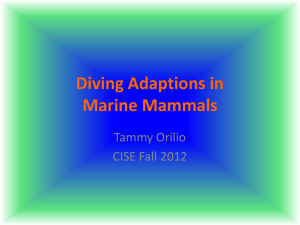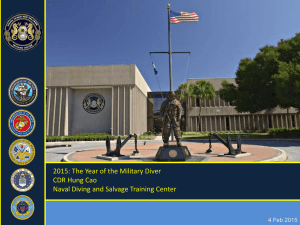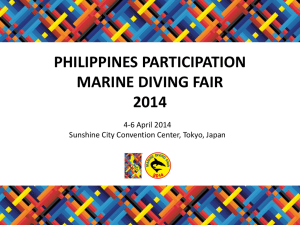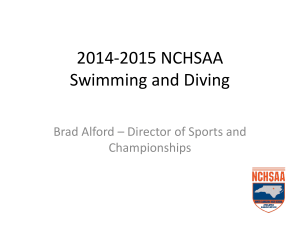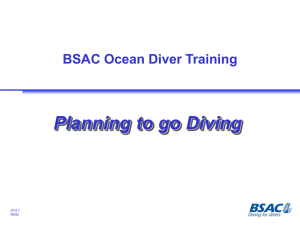Diving under Special Conditions
advertisement
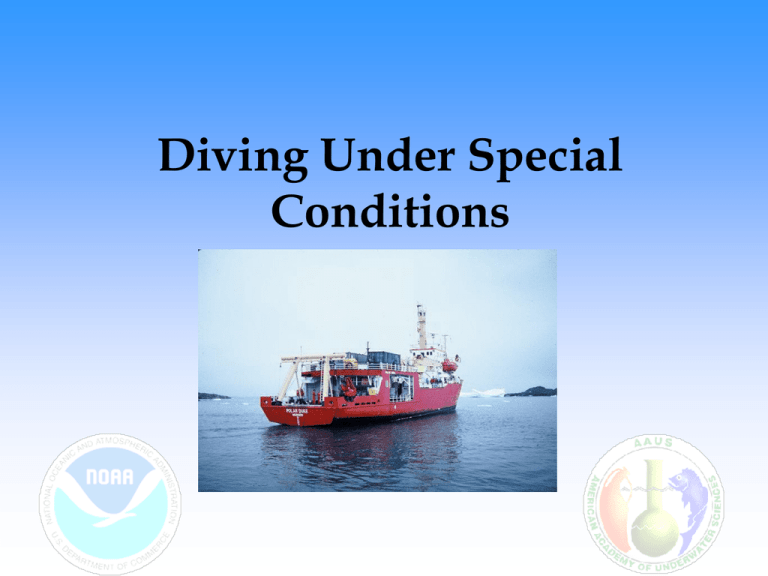
Diving Under Special Conditions References • Guide to Polar Diving. 1976. Office of Naval Research. • Heine, J.N. 1996. Cold Water Diving: A Guide to Ice Diving. Best Publishing Co, Flagstaff, AZ. • Heine, J.N. 1999. Scientific Diving Techniques. Best Publishing Company, Flagstaff, AZ. • Haddock, S.D.H., Heine, J.N. 2005. Scientific Blue-Water Diving. California Sea Grant Publ. No. T-057. • Joiner, J.T. 2001. NOAA Diving Manual: Diving for Science and Technology. Best Publishing Co. Flagstaff, AZ. Objectives • Upon completion of this module, the participant will be able to: – Describe the general diving conditions to be expected in the various geographic areas of the US – Discuss the aspects of diving from shore – Discuss the aspects of diving from a stationary platform – Discuss the aspects of diving from a small boat – Describe diving in freshwater, especially in the Great Lakes – Discuss the unique aspects of open-ocean diving and the techniques used – Discuss the aspects of diving on coral reefs, and in fast currents – Discuss the aspects of diving from shore Objectives (cont) • Upon completion of this module, the participant will be able to: – Discuss the special training and equipment required for cave diving – Discuss the special training and equipment required for cold water diving and diving under ice – Discuss the special training and equipment required for kelp, wreck, and night diving – Discuss the unique aspects of diving in dams and reservoirs, and the techniques used – Discuss the unique aspects of diving in rivers – Discuss the unique aspects of diving from a ship – Discuss the unique aspects of diving on pinnacles and seamounts – Discuss the unique aspects of diving in remote locations and coasts with difficult access – Discuss the unique aspects of diving in low and zero visibility – Discuss the unique aspects of diving in other unusual situations Geographic Regions • The diving conditions of the following coastal areas of the US and other areas will be described: – – – – – – – – – – Northeast Coast Mid-Atlantic Coast Southeast Coast Gulf of Mexico coast Northwest Coast Mid-Pacific Coast Southwest Coast Central Pacific Ocean Polar Tropics Northeast Coast • This area encompasses the coast from Maine to Rhode Island – Best diving occurs from June through October – During spring and summer, water temperatures range from 50-700F (10210C), with a significant thermocline. Temperatures at 100 ft (30 m) range from 48-540F (9-120C) – During winter, the temperature in the water column is homogeneous, with temperatures reaching as low as 28.50F (-20C) and very cold air temperatures – Water visibility can range from 50-80 ft (15-24m) during calm seas. During summer, red tide conditions may lower visibility to less than 1 foot (0.3 m) – Coastal waters in the Gulf of Maine have an average visibility of 10 ft (3 m), while south of Cape Cod it averages 10-15 ft (3-4.5 m) Northeast Coast (cont) • Several species of brown kelp are common, but do not form a surface canopy • Currents are generally tidal-driven • Surf is modest, but can be important along rocky shores such as the coast of Maine • Hazardous marine animals are not common – – – – Sharks have been seen, but are generally not of concern to divers Torpedo rays and stingrays are found off southern New England Goose-fish and wolffish may bite if startled Green sea urchins may be locally abundant Mid-Atlantic Coast • This area encompasses the coast from Rhode Island to Cape Hatteras – Water generally has low visibility and cold bottom temperatures – Shipwrecks abundant off New York-New Jersey coasts and off Cape Hatteras – During summer, surface water temperatures range from 72-750F (22-240C), with a significant thermocline, and bottom temperatures range from 40-600F (4-160C) – The Gulf Stream can bring warm water nearshore at Cape Hatteras – Underwater visibility is best from September-October • Visibility is typically low near estuaries, such as the Hudson and Chesapeake Mid-Atlantic Coast • Strong tidal currents can be expected in the Chesapeake Bay, parts of the New York Bight, off the Outer Banks of NC, and in Long Island Sound • The surf is generally moderate • Sharks are abundant, but there have been few encounters with divers • Goosefish common in the north • Stinging jellyfish can be abundant in summer Southeast Coast • This area encompasses the coast from Cape Hatteras to Florida – In northern parts, summer surface water temperatures are about 700F (210C), and winter temperatures drop to 500F (100C) – In the south temperatures of 75-800F (22-270C) are common, and winter temperatures drop to 65-700F (18-210C) – Visibility in the north averages 20-25 ft (6-8 m) – Visibility in the south is very good offshore, but drops to 25-30 (8-9.5 m) in harbors and bays – Care should be taken when diving near boundary currents such as the Gulf Stream – Shark attacks, while still very rare, are relatively high in Florida Gulf of Mexico • This area encompasses the area from the west coast of Florida to Texas – Surface water temperatures in the north range from 550F (130C) to about 850F (300C) seasonally. Thermoclines in spring and summer may have differences between surface and bottom waters of as much as 100F (60C) – Tides are semidiurnal along the west coast of Florida, but become diurnal and mixed to the north and west – Tidal ranges are relatively small, but currents can develop in small passes and inlets – Visibility is highly variable depending upon proximity to river discharges and location Gulf of Mexico (cont) – – – – Due to wide shelf, short period choppy waves are common Long and short-spined sea urchins are common Stinging hydrozoa such as fire coral, and jellyfish are common Stinging scorpion fish and rays are found Northwest Coast • This area encompasses the coast from Subarctic Alaska to Oregon 1. Alaska • Summer surface water temperatures are about 45-500F (7-100C), and winter temperatures drop to 34-380F (1-30C) • Visibility varies from 40-80 ft (12-24 m) in the Aleutians, and is usually 15-30 ft (4.5-9 m) in bays and straits • In southeast Alaska, spring blooms can reduce visibility to zero in the upper 30 ft (9 m) of the water column • Large tidal ranges cause high tidal currents • There are relatively few hazardous organisms, other than the usual urchins and jellyfish, and surface kelp canopies • Marine mammals such as killer whales and Steller sea lions may cause divers to keep out of the water Northwest coast (cont) 2. Washington and Oregon • • • • Water temperatures of 43-600F (6-160C) are common yearround Visibility is usually low in coastal waters, ranging from 525 ft (1.5-8 m), and from 0-70 ft (0-21 m) in protected Puget Sound waters Currents can be strong Surface kelp canopies may be present Mid-Pacific Coast • This area encompasses the coast of northern and Central California – From San Francisco north, the best diving conditions generally occur from June-September • Summer surface water temperatures are about 48-560F (9-130C) • Underwater visibility varies. In the Fort Bragg area summer visibility ranges between 10-15 ft (3-4.5 m), increasing to 15-25 ft (4.5-7.5 m) in the fall – From San Francisco south to Pt. Conception, good diving conditions may continue through December • Visibility is generally poor between Santa Cruz and San Francisco • In Monterey and Carmel Bays, visibility in fall can reach 100 ft (30 m) Mid-Pacific Coast (cont) • • • • Surf conditions are important when planning dives Strong currents can occur around headlands Kelp forests are extensive throughout the area Hazardous marine organisms include sea urchins, jellyfish, and rockfish • Shark attacks are not common, but have occurred. Diving is not recommended between Tomales Bay and Ano Nuevo Island Southwest Coast • This area encompasses the coast from Pt. Conception to the Northern Baja California peninsula • Summer surface water temperatures are about 55-700F (13210C), and winter temperatures drop to 50-600F (10-160C). There is a considerable thermocline in summer • Visibility ranges from 5-10 ft (1.5-3 m) along the coast to over 100 ft (30 m) around offshore islands. Best conditions are in the late summer through fall • Surf conditions should be evaluated prior to diving • Hazardous organisms include sharks, eels, sea urchins and jellyfish • Diving should be avoided around sewage outfalls Central Pacific Ocean • This area encompasses the coast around the Hawaiian and Leeward Islands – The average water temperature is 760F (240C) – Underwater visibility ranges from 50-100 ft (15-30 m) – Currents and high surf can be a problem – Hazardous organisms include sharks, eels, sea urchins and coral Arctic and Antarctic • Polar diving is remote and conditions can be extreme • Water temperatures may be as low as 280F (-20C), but air temperatures with wind chill can be much lower (-400F [400C]) • Hazardous organisms include killer whales, leopard seals and polar bears Diving From Shore • Safe entry and exit points must be identified • A dive flag should be displayed as required by law, and in areas of boat traffic. It should be towed if divers are swimming • Surf conditions should be carefully evaluated • All equipment should be donned and in place during surf entries and exits • Rip currents may be used for entries. If swimming towards shore, to get out of a rip current, swim parallel to the beach Diving From a Stationary Platform • Diving from a pier or platform allows for use of surface-supplied equipment • Ladders should be used where possible. Fins may have to removed for entry and exit • Ladder exits require a one-at-a-time procedure. Do not get near the ladder until the diver is safely onboard platform or boat • Be sure of sufficient water depth before entry Diving From a Small Boat • Vessels range from small inflatables, to dinghies, to larger solid-hull vessels. Common features include: – – – – – – – A means for divers to enter and exit the water easily and safely Seaworthy and capable of holding the load required Professional crew trained in boat handling and operation Shelter from the sun, cold, or inclement weather Ship-to-shore communications Properly maintained and in good repair Equipped with diver’s flag, emergency oxygen equipment, first aid kit, and drinking water – Being manned by a trained vessel operator while divers are in the water Diving From a Small Boat (cont) • Entering the water: – The back-roll method is best if the distance to the water is not greater than about 3-4 ft (0.91.2 m) Diving From a Small Boat (cont) • A ft-first entry, such as the “giant stride”, is generally used from a greater height using an opening in the gunwale • For exiting the water: – If using a dive ladder, equipment can be retained and fins removed and looped over the wrists – Alternatively, cylinders and weight belts can be removed and handed to surface personnel prior to exiting – Some ladders are designed to allow a fully-equipped diver to exit without removing fins – Ladder exits require a one-at-a-time procedure. Do not get near the ladder until the diver is safely onboard platform or boat – Larger vessels may have a “swim-step” off the transom that can be used for entering and exiting the water Freshwater Diving • Ocean divers must correct depth gauges and adjust buoyancy for freshwater diving • Great Lakes Diving: – In summer the upper layer (epilimnion) temperature ranges between 55-750F (13-240C). Below the thermocline (hypolimnion, typically at a depth of 60 ft [18 m]) temperatures average around 390F (40C) – In winter the water temperature ranges between 320F (00C) near the surface and 390F (40C) on the bottom. Diving under ice requires special training – Underwater visibility ranges from about 100 ft (30 m) in Lake Superior to less than 1 foot (0.3 m) in Lake Erie Freshwater Diving • Other water bodies: – There are many types of lakes, from clear mountain lakes, to reservoirs, to sedimentladen lakes and glacial lakes – Quarries and springs are also popular for diving – When planning a dive bottom terrain, entanglement hazards, algal blooms, and temperatures should be considered Open-Ocean Diving • Diving in the open ocean, called blue-water diving, does not have a fixed frame of reference (i.e., bottom), so divers may become easily disoriented • Special techniques have been developed for this type of diving (see Haddock and Heine, California Sea Grant, 2005) Open-Ocean Diving (cont) • Overview of a blue-water dive, showing downline array. Divers are tethered to a down-line and a safety diver serves as a buddy for each working diver, and controls the dive Open-Ocean Diving (cont) • The down-line is securely fastened to the vessel, and has depth markers and loops to attach the tether at various depths • Other details include a wave damper, shark billy, and light weight (ca 3 lb/1.5 kg) Open-Ocean Diving (cont) Trapeze keeps divers connected to the down-line Various designs are shown here: A. Aluminum bar B. Polypropylene bar with deep-D stainless steel shackles C. U-shaped “boom bail” D. Stainless steel rod hoop E. Stainless steel rod triangle Open-Ocean Diving (cont) • Details of diver’s tether and quickrelease lines Coral Reefs and Fringing Reefs • Tidal changes may affect entry and exit points • Currents can be strong in reef passes • Rough seas may appear at the reef edge • Adequate protection from sharp coral should be used Fast Current • Currents of greater than 1 knot can be difficult for divers to swim against • Drift diving with the current can be useful for surveying large areas – Divers should trail surface floats, which are tended by a maneuvering boat – Divers should also carry surface signaling devices such as flares or a safety sausage Cave Diving • Limited overhead access, visibility, and confined-spaces in caves require special training and equipment – Special hazards include: • The absence of a direct and immediate ascent route to the surface • The sometimes instantaneous loss of visibility due to silting or failure of diver’s light • The entanglement and impact hazards associated with being in a confined, enclosed space Cave Diving (cont) Four basic rules for cave-diving safety include: 1. Always use a continuous guideline to the surface 2. Save two-thirds of the total air supply for returning to the surface 3. Carry at least three lights during the dive 4. Carry a redundant scuba regulator and any other equipment where the direct malfunction of which could cause a fatality Safety reel Cave Diving (cont) • Standard cave diving life-support systems should include: – – – – – – – – – – – – – – Double cylinders Double manifolds with captured o-rings Two regulators Submersible pressure gauge Buoyancy compensator with power inflator Depth gauge Timer (computer) Decompression tables Exposure suit Safety reel and line Lights Compass Slate Pencil Cold Water Diving • Diving in cold water presents potential equipment problems such as regulator freeze-up and free-flow – Several models designed to resist freezing are available – Divers should submerge before breathing from or purging the regulator • Rapid, prolonged inflation of drysuits or buoyancy compensators should also be avoided • Drysuits are commonly used, and special training is required for their usage • Thermal protection, especially of the extremities, is important. Dry gloves can be fitted to drysuit sleeves • Facilities must be available for divers and surface tenders to stay warm • See Heine (1996) for detailed information on cold water diving Diving Under Ice • Specialized training and equipment are required for diving under ice • Solid ice offers a stable platform with little or no seas, but currents are possible • Ice thickness must be determined by drilling a small hole Diving Under Ice (cont) • Triangular dive holes allow access for up to three divers at a time • Each diver has a surface tender, and there is at least one standby diver for the group • Divers are tethered to a line securely fastened on the surface • Excursion distances from the entry hole should be kept to a minimum (90 ft or 27 m) • See Heine (1996) for detailed information on diving under ice Kelp Diving • There are many species of kelp, some forming low-lying bottom canopies, while others grow up and form a thick surface canopy • Holdfasts anchor the plant to the substrate, while hollow floats buoy the long stipes and fronds up to the surface • The surface canopy can be very thick, and care must be taken when entering and exiting • Divers should be sure their equipment is streamlined to reduce snagging and entanglement • Kelp has great tensile strength, but can be broken by bending Wreck Diving • Penetration of wrecks requires special training and equipment • Most intact wrecks are in deeper water (80 ft or 24 m, or greater) – Twin scuba cylinders and redundant air supply are recommended • Visibility can be limited, and the use of a safety reel is mandatory • Entanglement is a real concern Night Diving • A properly anchored and lighted vessel must be attended during the dive • Each diver must carry a primary and a backup light • A chemical light can be taped to the snorkel or cylinder valve for underwater and surface visibility • Hand signals should be practiced. They can be made against the diver’s chest while shining the light toward oneself Night Diving (cont) Predive 1. 2. 3. Lights- adequate light for surface team. May need lighting for entry/exit point, and vessel Markers- jackstays or shot-lines should be used where necessary Briefing- to include tasks, routes to a from the site, entry and exit, and safety procedures Dive 1. 2. Safety- a lifeline to the surface may be required Light- there is usually some ambient light at night. Diver’s must carry battery-powered lights and should use chemical light sticks Postdive 1. Safety- For decompression diving, a lighted decompression line is essential. Adequate thermal protection should be available for divers Diving in Dams and Reservoirs • • • Many of the same procedures are used as in cave and wreck diving Dive planning with site personnel is critical for safe operations There are four major considerations in dive planning: 1. 2. 3. 4. Depth Water temperature Visibility Flow velocities Diving in Dams and Reservoirs (cont) • Depth – Can vary greatly and be quite deep around dams • Water temperatures can vary from 800F (270C) in summer to slightly above freezing in winter • Spring runoff from rivers can produce low visibility. Sediment can also reduce visibility to near zero • Diving in dam gatewells must be carefully coordinated with dam personnel to prevent suction at the orifice • Diving in fish ladders can involve high water flows Diving in Dams and Reservoirs (cont) • Diving at Water Withdrawal and Pumping Sites – Divers may be required to inspect fish screens – Several types of water-withdrawal sites are common: • A vault-like structure with a screened underwater opening • A pier-like structure set out from the shoreline that supports turbine pumps • A combination pier/vault created by closing in the area under a pier • A simple arrangement of a pump or siphon with a single intake line extending below the low-water level River Diving • Rivers vary greatly in size, turbidity, terrain, flow and temperature • Hazards such as log jams, submerged rocks, trees, old cars, barbed wire, and fishing lines may be encountered • When working with lines, tethers, or umbilicals in a current should be aware of the drag on them • Ascending and descending in a swift current can be difficult River Diving (cont) • A “creeper” device can be used to move across the bottom in swift currents: Diving from a Ship • There are a number of personnel that may be involved in diving operations from a larger vessel. They must communicate and discuss logistics before any diving operation takes place – The ship’s captain has the final decision in any matter pertaining to the vessel and its operation – The divemaster is responsible for all aspects of the diving operation – The science coordinator, in conjunction with the captain and divemaster, ensures that the scientific goals of the diving mission are achieved Diving from a Ship (cont) • A suitable diving storage locker should be used. It should be equipped with backup diving gear • Air compressors should be positioned with the intake towards the bow of the vessel, and away from any paints, solvents, or other chemicals • If diving in a remote region or far offshore, evacuation plans must be in place • A decompression chamber may be required onboard if decompression, repetitive, or deep diving are planned • Use of a small dive-support vessel is recommended Diving from a Ship (cont) • Diving While Underway – Divers may be required to make underwater observations on towed equipment or instruments – The small boat can maneuver the divers into position to enter in front of the towed system – Special care must be taken to avoid entanglement, entrapment, and being forced against bottom obstructions. Divers must always carry a sharp knife – Jellyfish may pose a particular hazard when diving on trawls – Towed speeds of over 3 knots (1.5 m/s) preclude divers from holding onto nets, and may cause mouthpieces and/or face masks to become dislodged – Wireless communications should be considered. Color-coded float balls can be used to signal the surface Pinnacle and Seamount Diving • Pinnacles often have relatively flat tops and steep sides, and may have significant currents • In oceanic conditions, divers should be tended from a small boat • A downline marked with depths may be used • Sharks may be present, and divers should carry a shark billy Diving in Remote Locations and on Coasts of Difficult Access • Emergency evacuation of an injured diver must be thoroughly planned for • Boats should have flares, dye markers, compass, survival packs, drinking water, satellite phone, and GPS • An emergency safety vessel should be considered • A DMT and emergency medical supplies should be onhand • Medical, rescue, and recompression facilities may not be available. Extra safety measures should be used Diving in Low and Zero Visibility • The ability to navigate accurately is reduced • Other marine hazards, such as entanglement, dangerous marine organisms, and injuries from work-related tools may be more likely • A standby diver should be available • Conservative planning relative to depth, underwater time, and air consumption should be considered • Lifelines should be used, if appropriate • Other equipment to be carried include a sharp knife and lights Other Unusual Situations • Noxious gas in bottom water – Gases such as hydrogen sulfide, ammonia, and methane can occur in anoxic waters around fish cages and mussel rafts – Drysuits and positive-pressure face masks should be considered • Fish tanks, cages, farms, floating systems – Diving in enclosures has the potential for entanglement and trapping Other Unusual Situations (cont) • Diving around enclosures – Larger mesh netting can be especially dangerous for entanglement – Predators may be associated with fish cages • Diving within enclosures – Small enclosures may only allow one diver, so a fullydressed standby diver should be ready – A diver safety line, and/or weighted shot line should be used Other Unusual Situations (cont) • Oceanographic engineering – Equipment may need to be placed, monitored, or operated by divers – Heavy equipment may be managed by using lift bags Diving Modes Requiring Specialized Training and Authorization • The following modes of diving may require further specialized training before being utilized: – – – – – Nitrox diving Mixed gas diving Surface supplied diving Hookah diving Staged decompression diving Blue water diving Ice and polar diving Saturation diving Overhead environments (cave, wreck penetration) Study Questions • Use the following study questions to review some of the information presented in this self study module. When you are finished you can print out your study questions results. Self-study Questions Which of these coasts encompass the area of Maine to Rhode Island? a. b. c. d. Southeast Coast Northeast Coast Gulf of Mexico Coast Mid-Atlantic Coast Self-study Questions Which of these coasts encompass the area of Maine to Rhode Island? a. b. c. d. Southeast Coast Northeast Coast Gulf of Mexico Coast Mid-Atlantic Coast Self-study Questions In the Northeast Coast during the spring and summer water temperatures at _____ range from 4854 degrees Fahrenheit (9-21 C). a. 50 feet b. 75 feet c. 100 feet d. 125 feet Self-study Questions In the Northeast Coast during the spring and summer water temperatures at _____ range from 4854 degrees Fahrenheit (9-21 C). a. 50 feet b. 75 feet c. 100 feet d. 125 feet Self-study Questions During what months is underwater visibility best in the Mid-Atlantic Coast? a. b. c. d. September-November August-October September-October August-November Self-study Questions During what months is underwater visibility best in the Mid-Atlantic Coast? a. b. c. d. September-November August-October September-October August-November Self-study Questions The fish common to the Gulf of Mexico with the worst reputation for biting is the _____. a. b. c. d. Grey triggerfish Great barracuda Sand tiger shark toadfish Self-study Questions The fish common to the Gulf of Mexico with the worst reputation for biting is the _____. a. b. c. d. Grey triggerfish Great barracuda Sand tiger shark toadfish Self-study Questions What is the highest temperature that is normally reached in the Northwest Coast during summer? a. b. c. d. 34 degrees Fahrenheit 38 degrees Fahrenheit 45 degrees Fahrenheit 50 degrees Fahrenheit Self-study Questions What is the highest temperature that is normally reached in the Northwest Coast during summer? a. b. c. d. 34 degrees Fahrenheit 38 degrees Fahrenheit 45 degrees Fahrenheit 50 degrees Fahrenheit Self-study Questions The mid-Pacific costal region includes the waters of Northern and Central California. From San Francisco north, the best diving conditions in terms of water temperature and visibility generally occur from June through September. From San Francisco south to Point Conception, good diving conditions may continue through _____. a. November b. December c. January d. February Self-study Questions The mid-Pacific costal region includes the waters of Northern and Central California. From San Francisco north, the best diving conditions in terms of water temperature and visibility generally occur from June through September. From San Francisco south to Point Conception, good diving conditions may continue through _____. a. November b. December c. January d. February Self-study Questions The average water temperature around the major islands in the Central Pacific Ocean is _____. a. b. c. d. 74 degrees Fahrenheit 75 degrees Fahrenheit 76 degrees Fahrenheit 77 degrees Fahrenheit Self-study Questions The average water temperature around the major islands in the Central Pacific Ocean is _____. a. b. c. d. 74 degrees Fahrenheit 75 degrees Fahrenheit 76 degrees Fahrenheit 77 degrees Fahrenheit Self-study Questions Jellyfish abound in the Tropics. a. True b. False Self-study Questions Jellyfish abound in the Tropics. a. True b. False Self-study Questions A boat used as a diving platform should be: (select all that apply) a. equipped with a means for divers to enter and exit the water easily and safely b. seaworthy and not loaded beyond the capacity recommended by the manufacturer for the expected conditions c. equipped with ship-to-shore communications d. maintained properly and in good repair e. carrying a diver's flag, oxygen kit, first aid equipment, and drinking water f. Manned by a trained vessel operator while divers are in the water g. All of the above Self-study Questions A boat used as a diving platform should be: (select all that apply) a. equipped with a means for divers to enter and exit the water easily and safely b. seaworthy and not loaded beyond the capacity recommended by the manufacturer for the expected conditions c. equipped with ship-to-shore communications d. maintained properly and in good repair e. carrying a diver's flag, oxygen kit, first aid equipment, and drinking water f. Manned by a trained vessel operator while divers are in the water g. All of the above Self-study Questions In the Great Lakes, the water below the thermocline approach the temperature of maximum density for freshwater, ___. a. b. c. d. 39 degrees Fahrenheit 32 degrees Fahrenheit 55 degrees Fahrenheit 75 degrees Fahrenheit Self-study Questions In the Great Lakes, the water below the thermocline approach the temperature of maximum density for freshwater, ___. a. b. c. d. 39 degrees Fahrenheit 32 degrees Fahrenheit 55 degrees Fahrenheit 75 degrees Fahrenheit Self-study Questions Most open-ocean divers carry shark billies. a. True b. False Self-study Questions Most open-ocean divers carry shark billies. a. True b. False Self-study Questions Currents of 1 knot are considered the common limit for divers to be able to swim against. A. True B. False Self-study Questions Currents of 1 knot are considered the common limit for divers to be able to swim against. A. True B. False Self-study Questions Which of these is NOT a special hazard normally associated with cave diving? A.The absence of a direct and immediate ascent route to the surface B. The sometimes instantaneous loss of visibility because of silting or failure of the diver’s light C. The entanglement and impact hazards associated with being in a confined, enclosed space D.Being dragged to the surface while deploying a lift-bag for a marker buoy Self-study Questions Which of these is NOT a special hazard normally associated with cave diving? A.The absence of a direct and immediate ascent route to the surface B. The sometimes instantaneous loss of visibility because of silting or failure of the diver’s light C. The entanglement and impact hazards associated with being in a confined, enclosed space D.Being dragged to the surface while deploying a lift-bag for a marker buoy Self-study Questions Every cave diver must carry at least _____ lights during a dive. a.Two b.Three c. Four d.five Self-study Questions Every cave diver must carry at least _____ lights during a dive. a.Two b.Three c. Four d.five Self-study Questions Diving in cold water and at or near freezing temperatures presents potential equipment problems such as regulator freeze-up and freeflow. In an attempt to avoid cold related equipment problems, divers can/should: (select all that apply) A. B. C. D. E. select regulator models designed to resist freezing submerge before breathing from or purging the regulator. Avoid rapid or prolonged inflation of dry suit or buoyancy compensator. Pre-chill the regulator before the dive Pay attention to early signs of a potential regulator freeze-up such as ice crystals on the tongue and abort the dive should these signs occur. Self-study Questions Diving in cold water and at or near freezing temperatures presents potential equipment problems such as regulator freeze-up and free-flow. In an attempt to avoid cold related equipment problems, divers can/should: (select all that apply) A. select regulator models designed to resist freezing B. submerge before breathing from or purging the regulator. C. Avoid rapid or prolonged inflation of dry suit or buoyancy compensator. D. Pre-chill the regulator before the dive E. Pay attention to early signs of a potential regulator freeze-up such as ice crystals on the tongue and abort the dive should these signs occur. Self-study Questions Penetration wreck diving, like cave diving, requires special training and equipment. Select the true statements concerning wreck diving. A.Most intact wrecks are at depths in excess of 80 ft. (24.4 m). B. Few intact wrecks can be found within divable depth ranges. C. Entanglements are a real concern. D.Visibility can be limited. E. The use of a safety reel is mandatory. F. A single scuba cylinder equipped with a J-valve is the recommended configuration for wreck diving. Self-study Questions Penetration wreck diving, like cave diving, requires special training and equipment. Select the true statements concerning wreck diving. A.Most intact wrecks are at depths in excess of 80 ft. (24.4 m). B. Few intact wrecks can be found within divable depth ranges. C. Entanglements are a real concern. D.Visibility can be limited. E. The use of a safety reel is mandatory. F. A single scuba cylinder equipped with a J-valve is the recommended configuration for wreck diving. Self-study Questions Aside from the need for diver carried lights, there are few concerns to consider when night diving. A.True B.False Self-study Questions Aside from the need for diver carried lights, there are few concerns to consider when night diving. A.True B.False Self-study Questions Which of these is NOT one of the four major conditions to be considered when planning dives at dams? A.Depth B. Water temperature C. Visibility D.Flow velocities E. Current direction Self-study Questions Which of these is NOT one of the four major conditions to be considered when planning dives at dams? A.Depth B. Water temperature C. Visibility D.Flow velocities E. Current direction Self-study Questions Towed speeds of over _____ preclude divers from holding onto nets, and may cause mouthpieces and/or face masks to become dislodged. A.2 Knots B.3 Knots C.4 Knots D.5 Knots Self-study Questions Towed speeds of over _____ preclude divers from holding onto nets, and may cause mouthpieces and/or face masks to become dislodged. A.2 Knots B.3 Knots C.4 Knots D.5 Knots Self-study Questions Noxious gasses such as _____ commonly occur in anoxic halos from concentrations of fecal matter under fish cages and mussel rafts, as well as in areas of sewage settlement or low water flow. (Select all that apply) A.Methane B. Ammonia C. Hydrogen Sulfide D.All the above Self-study Questions Noxious gasses such as _____ commonly occur in anoxic halos from concentrations of fecal matter under fish cages and mussel rafts, as well as in areas of sewage settlement or low water flow. (Select all that apply) A.Methane B. Ammonia C. Hydrogen Sulfide D.All the above
